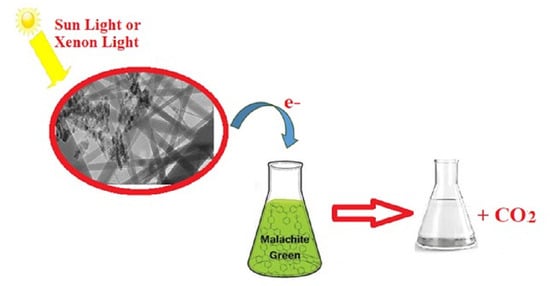Photocatalytic Degradation of Malachite Green Dye from Aqueous Solution Using Environmentally Compatible Ag/ZnO Polymeric Nanofibers
Abstract
:1. Introduction
2. Materials and Methods
2.1. Materials
2.2. Methods
2.2.1. Green Synthesis of ZnO Nanoparticles as Filler
2.2.2. Synthesis of Polypyrrole (Ppy) Nanoparticles
2.3. Fabrication of ZnO Polymeric Composite Nanofiber
Preparation of ZnO Nanoparticles as Filler into the Polymeric Composite Solution
2.4. Electrospinning of ZnO Polymeric Composite Nanofiber
2.5. Surface Modification of ZnO Polymeric Composite Nanofiber by Silver Immobilization
2.6. Characterization of ZnO Polymeric Composite Nanofibers before and after Silver Immobilization
2.7. Photocatalytic Degradation of Malachite Green Dye Using Various Fabricated ZnO Polymeric Composite Nanofibers
2.8. Reusability of Fabricated ZnO Polymeric Composite Nanofibers
3. Results
3.1. Optimization of the Fabrication of ZnO Polymeric Composite Nanofibers
3.2. Silver Immobilization onto ZnO Polymeric Composite Nanofibers for Enhancing Photocatalytic Activity
3.3. Comparable Investigation of the Prepared ZnO Polymeric Composite Nanofibers before and after Silver Immobilization
3.3.1. X-ray Diffraction Patterns (XRD)
3.3.2. FTIR-Spectrophotometric Analysis
3.3.3. Thermo-Gravimetric Analysis (TGA)
3.4. Photocatalytic Characteristics of ZnO Polymeric Nanofibers for Malachite Green Dye Degradation
3.4.1. Effect of Contact Time
3.4.2. Effect of Malachite Green Dye Concentration
3.4.3. Effect of Polymeric Nanofiber Dosage
3.4.4. Effect of Solutions pH
3.4.5. Effect of Reaction Temperature
3.5. Reusability of Fabricated ZnO Polymeric Composite Nanofibers
3.6. Suggested Mechanism of Malachite Green Dye Degradation Using ZnO Polymeric Nanofibers
4. Conclusions
Author Contributions
Funding
Institutional Review Board Statement
Informed Consent Statement
Data Availability Statement
Acknowledgments
Conflicts of Interest
References
- Ananpattarachai, J.; Kajitvichyanukul, P.; Seraphin, S. Visible light absorption ability and photocatalytic oxidation activity of various interstitial N-doped TiO2 prepared from different nitrogen dopants. J. Hazard. Mater. 2009, 168, 253–261. [Google Scholar] [CrossRef]
- Elkady, M.F.; Hassan, H.S. Invention of Hollow Zirconium Tungesto-Vanadate at Nanotube Morphological Structure for Radionuclides and Heavy Metal Pollutants Decontamination from Aqueous Solutions. Nanoscale Res. Lett. 2015, 10, 1–6. [Google Scholar] [CrossRef] [Green Version]
- Hassan, H.S.; Elkady, M.; Farghali, A.; Salem, A.M.; El-Hamid, A.A. Fabrication of novel magnetic zinc oxide cellulose acetate hybrid nanofiber to be utilized for phenol decontamination. J. Taiwan Inst. Chem. Eng. 2017, 78, 307–316. [Google Scholar] [CrossRef]
- Chequer, F.; de Oliveira, G.; Ferraz, E.; Cardoso, J.; Zanoni, M.; de Oliveira, D.P. Textile Dyes: Dyeing Process and Environmental Impact. In Book Title Eco-Friendly Textile Dyeing and Finishing; Gunay, M., Ed.; IntechOpen Limited: London, UK, 2013; Volume 6, pp. 151–176. [Google Scholar]
- Elkady, M.F.; Hassan, H.S.; Amer, W.A.; Salama, E.; Algarni, H.; Shaaban, E.R. Novel Magnetic Zinc Oxide Nanotubes for Phenol Adsorption: Mechanism Modeling. Materials 2017, 10, 1355. [Google Scholar] [CrossRef] [PubMed] [Green Version]
- Glavič, P.; Lukman, R. Review of sustainability terms and their definitions. J. Clean. Prod. 2007, 15, 1875–1885. [Google Scholar] [CrossRef]
- Elkady, M.; Hassan, H.S.; Hashim, A. Immobilization of Magnetic Nanoparticles onto Amine-Modified Nano-Silica Gel for Copper Ions Remediation. Materials 2016, 9, 460. [Google Scholar] [CrossRef]
- Hassan, H.S.; Kashyout, A.; Morsi, I.; Nasser, A.; Abuklill, H. Development of polypyrrole coated copper nanowires for gas sensor application. Sens. Bio-Sens. Res. 2015, 5, 50–54. [Google Scholar] [CrossRef] [Green Version]
- Sharma, S.; Kaur, A. Various methods for removal of dyes from industrial effluents: A review. Indian J. Sci. Technol. 2018, 11, 1–21. [Google Scholar] [CrossRef]
- Kamat, P. Manipulation of charge transfer across semiconductor interface a criterion that cannot be ignored in photo catalyst design. J. Phys. Chem. Lett. 2012, 3, 663–672. [Google Scholar] [CrossRef]
- Hammad, A.; Haitham, M.; El-Bery, H.M.; EL-Shazly, A.H.; Elkady, M. Effect of WO3 Morphological Structure on its Photoelectrochemical Properties. Int. J. Electrochem. Sci. 2018, 13, 362–372. [Google Scholar] [CrossRef]
- Bansal, P.; Bhullar, N.; Sud, D. Studies on photodegradation of malachite green using TiO2/ZnO photocatalyst. Desalin. Water Treat. 2009, 12, 108–113. [Google Scholar] [CrossRef] [Green Version]
- Hammad, A.; Akihiko, A.; Xing, Z.; Akira, Y.; Daiki, O.; Teppei, Y.; EL-Shazly, A.; Elkady, M.; Hisao, Y. Photodeposition conditions of silver cocatalyst on titanium oxide photocatalyst directing product selectivity in photocatalytic reduction of carbon dioxide with water. Catal. Lett. 2020, 150, 1081–1088. [Google Scholar] [CrossRef]
- Oualid, H.; Mahdi, C.; Emmanuel, N. Ultrasound-assisted removal of malachite green from aqueous solution by dead pine needles. J. Ultrason. Sonochem. 2008, 15, 799–807. [Google Scholar]
- Frontistis, Z.; Hapeshi, E.; Fatta-Kassinos, D.; Mantzavinos, D. Ultraviolet-activated persulfate oxidation of methyl orange: A comparison between artificial neural networks and factorial design for process modelling. Photochem. Photobiol. Sci. 2015, 14, 528–535. [Google Scholar] [CrossRef]
- El-Aassar, M.; El-Kady, M.; Hassan, H.S.; Al-Deyab, S.S. Synthesis and characterization of surface modified electrospun poly (acrylonitrile-co-styrene) nanofibers for dye decolorization. J. Taiwan Inst. Chem. Eng. 2016, 58, 274–282. [Google Scholar] [CrossRef]
- Deitzel, J.; Kleinmeyer, J.; Harris, D.; Beck, N. The effect of processing variables on the morphology of electrospun nanofi-bers and textiles. J. Polymer. 2001, 42, 261–272. [Google Scholar] [CrossRef]
- Shokry, H.; Elkady, M.; Salama, E. Eco-friendly magnetic activated carbon nano-hybrid for facile oil spills separation. Sci. Rep. 2020, 10, 1–17. [Google Scholar] [CrossRef]
- Mohy-Eldin, M.S.; Elkady, M.F.; Abu-Saied, M.A.; Rahman, A.M.A.; Soliman, E.A.; Elzatahry, A.A.; Youssef, M.E. Removal of cadmium ions from synthetic aqueous solutions with a novel nanosulfonated poly(glycidyl methacrylate) cation exchanger: Kinetic and equilibrium studies. J. Appl. Polym. Sci. 2010, 118, 3111–3122. [Google Scholar] [CrossRef]
- Ebrahimiasl, S.; Zakaria, A.; Kassim, A.; Basri, S.N. Novel conductive polypyrrole/zinc oxide/chitosan bionanocomposite: Synthesis, characterization, antioxidant, and antibacterial activities. Int. J. Nanomed. 2014, 10, 217–227. [Google Scholar] [CrossRef] [Green Version]
- Saddeek, Y.; Shokry Hassan, H.; Abd Elfadeel, G. F Fabrication and analysis of new bismuth borate glasses containing cement kiln dust. J. Non-Cryst. Solids 2014, 403, 47–52. [Google Scholar] [CrossRef]
- Phiriyawirut, M.; Phaechamud, T. Gallic acid-loaded cellulose acetate electrospun nanofibers: Thermal properties, mechanical properties and drug release behavior. J. Polym. Chem. 2012, 2, 1–29. [Google Scholar] [CrossRef]
- Zhang, H.; Zong, R.; Zhao, J.; Zhu, Y. Dramatic Visible Photocatalytic Degradation Performances Due to Synergetic Effect of TiO2with PANI. Environ. Sci. Technol. 2008, 42, 3803–3807. [Google Scholar] [CrossRef]
- Tripathy, N.; Ahmad, R.; Kuk, H.; Lee, D.H.; Hahn, Y.-B.; Khang, G. Rapid methyl orange degradation using porous ZnO spheres photocatalyst. J. Photochem. Photobiol. B Biol. 2016, 161, 312–317. [Google Scholar] [CrossRef]
- Elkady, M.F.; Hassan, H.S.; Salama, E. Sorption Profile of Phosphorus Ions onto ZnO Nanorods Synthesized via Sonic Technique. J. Eng. 2016, 2016, 1–9. [Google Scholar] [CrossRef] [Green Version]
- Ma, S.; Li, R.; Lv, C.; Xu, W.; Gou, X. Facile synthesis of ZnO nanorod arrays and hierarchical nanostructures for photo-catalysis and gas sensor applications. J. Hazard. Mater. 2011, 192, 730–740. [Google Scholar] [CrossRef]
- Tijing, L.; Amarjargal, A.; Jiang, Z.; Ruelo, M.; Park, C.; Pant, H.; Kim, D.; Lee, D.; Kim, C. Antibacterial tourmaline nanoparticles/polyurethane hybrid mat decorated with silver nanoparticles prepared by electrospinning and UV photo reduction. Curr. Appl. Phys. 2013, 13, 205–210. [Google Scholar] [CrossRef]
- Fathona, I.; Yabuki, A. A simple one-step fabrication of Short polymer nano-fibers via electrospinning. J. Mater. Sci. 2014, 49, 3519–3528. [Google Scholar] [CrossRef]
- Megelski, S.; Stephens, J.S.; Chase, A.D.B.; Rabolt, J.F. Micro- and Nanostructured Surface Morphology on Electrospun Polymer Fibers. Macromolecules 2002, 35, 8456–8466. [Google Scholar] [CrossRef]
- Buchko, C.; Loui, C.; Shen, Y.; David, C. Processing and microstructural characterization of porous biocompatible protein polymer thin films. J. Polym. 1999, 40, 7397–7407. [Google Scholar] [CrossRef]
- Viet, T.; The, C.; Tri, P.; Tien, P.; Manh, L. Synergistic Adsorption and Photocatalytic Activity under Visible Irradiation Using Ag-ZnO/GO Nanoparticles Derived at Low Temperature. J. Chem. 2019, 2019, 1–13. [Google Scholar]
- Elkady, M.F.; Shokry Hassan, H.; El-Sayed, E.M. Basic Violet Decolourization Using Alginate Immobilized Nanozir-conium Tungestovanadate Matrix as Cation Exchanger. J. Chem. 2015, 2015, 385741. [Google Scholar] [CrossRef] [Green Version]
- Wang, J.; Wei, B.; Kang, F. facile synthesis of hierarchical conducting polypyrrole nano-structures via a reactive tem-plate of MnO2 and their application in super capacitors. RSC Adv. 2014, 4, 199–202. [Google Scholar] [CrossRef]
- Guanggui, C.; Jianning, D.; Zhongqiang, Z.; Zhiyong, L.; Huasheng, P. Study on the preparation and multi properties of the polypyrrole films doped with different ions. Surf. Interface Anal. 2012, 44, 844–850. [Google Scholar] [CrossRef]
- Samy, M.; Mossad, M.; El-Etriby, H.K. Synthesized nano titanium for methylene blue removal under various operational conditions. Desalin. Water Treat. 2019, 165, 374–381. [Google Scholar] [CrossRef]
- Azizi, S.; Ahmad, M.; Hussein, M.; Ibrahim, N.; Namvar, F. Preparation and properties of poly(vinyl-alcohol)/chitosan blend bio-nanocomposites reinforced with cellulose nanocrystals/ZnO-Ag multifunctional nanosized filler. Int. J. Nanomed. 2014, 9, 1909–1917. [Google Scholar] [CrossRef] [PubMed] [Green Version]
- Ramalingam, V.; Rajaram, R.; PremKumar, C.; Santhanam, P.; Dhinesh, P.; Vinothkumar, S.; Kaleshkumar, K. Bio-synthesis of silver nanoparticles from deep sea bacterium Pseudomonas aeruginosa JQ989348 for antimicrobial, antibiofilm and cytotoxic activity. J. Basic Microbiol. 2014, 54, 928–936. [Google Scholar] [CrossRef]
- Modwi, A.; Abbo, M.; Hassan, E.; Al-Duaij, O.; Houas, A. Adsorption kinetics and photocatalytic degradation of malachite green (MG) via Cu/ZnO nanocomposites. J. Environ. Chem. Eng. 2017, 5, 5954–5960. [Google Scholar] [CrossRef]
- Hachem, C.; Bocquillon, F.; Zahraa, O.; Bouchy, M. Decolourization of textile industry wastewater by the photocatalytic degradation process. Dye. Pigment. 2001, 49, 117–125. [Google Scholar] [CrossRef]
- Sohrabi, M.; Davallo, M.; Miri, M. Influence of operational parameters on eliminating azo dyes from wastewater by advanced oxidation technology. Int. J. Chem. Tech. Res. 2009, 1, 446–451. [Google Scholar]
- Muruganandham, M.; Swaminathan, M. Photocatalytic decolourisation and degradation of reactive orange 4 by TiO2-UV process. Dyes Pigment. 2006, 68, 133–142. [Google Scholar] [CrossRef]
- Zhang, T.; Oyama, T.; Horikoshi, S.; Hidaka, H.; Zhao, J.; Serpone, N. Photocatalyzed N-demethylation and degrada-tion of methylene blue in titania dispersions exposed to concentrated sunlight. Sol. Energy Mater. Sol. Cells. 2002, 73, 287–303. [Google Scholar] [CrossRef]
- Diab, K.E.; Salama, E.; Hassan, H.S.; El-Moneim, A.A.; Elkady, M.F. Biocompatible MIP-202 Zr-MOF tunable sorbent for cost-effective decontamination of anionic and cationic pollutants from waste solutions. Sci. Rep. 2021, 11, 1–13. [Google Scholar] [CrossRef]
- Gar Alalm, M.; Samy, M.; Ookawara, S.; Ohno, T. Immobilization of S-TiO2 on reusable aluminum plates by pol-ysiloxane for photocatalytic degradation of 2,4-dichlorophenol in water. J. Water Process. Eng. 2018, 26, 329–335. [Google Scholar] [CrossRef]
- Hassan, H.S. Role of preparation technique in the morphological structures of innovative nano-cation exchange. J. Mater. Res. Technol. 2019, 8, 2854–2864. [Google Scholar] [CrossRef]
- Elkady, M.F.; El-Aassar, M.R.; Hassan, H.S. Adsorption profile of basic dye onto novel fabricated carboxylated func-tionalized co-polymer nanofibers. Polymers 2016, 8, 177. [Google Scholar] [CrossRef] [Green Version]
- Mahanna, H.; Azab, M. Adsorption of Reactive Red 195 dye from industrial wastewater by dried soybean leaves modified with acetic acid. Desalin. Water Treat. 2020, 178, 312–321. [Google Scholar] [CrossRef]
- Penghui, S.; Shuiping, Y.; Xiaoguang, D.; Liming, Y.; Hui, S.; Lin, D.; Jiayu, T.; Lixia, Y.; Xubiao, L.; Shaobin, W. Potential Difference Driving Electron Transfer via Defective Carbon Nanotubes toward Selective Oxidation of Organic Micropollutant. Environ. Sci. Technol. 2020, 54, 8464–8472. [Google Scholar]
- Penghui, S.; Jiayu, T.; Feng, Y.; Xiaoguang, D.; Shanshan, G.; Wenxin, S.; Xubiao, L.; Fuyi, C.; Shenglian, L.; Shaobin, W. Identification and Regulation of Active Sites on Nanodiamonds: Establishing a Highly Efficient Catalytic System for Oxidation of Organic Contaminants. Adv. Funct. Mater. 2018, 28, 1705295–1705303. [Google Scholar]
- Penghui, S.; Xiaoguang, D.; Jun, X.; Jiayu, T.; Wenxin, S.; Shanshan, G.; Mingjun, X.; Fuyi, C.; Shaobin, W. Heterogeneous activation of peroxymonosulfate by amorphous boron for degradation of bisphenol S. J. Hazard. Mater. 2017, 322, 532–539. [Google Scholar]
- Samy, M.; Alalm, M.G.; Mossad, M. Utilization of iron sludge resulted from electro-coagulation in heterogeneous photo-Fenton process. Water Pr. Technol. 2020, 15, 1228–1237. [Google Scholar] [CrossRef]
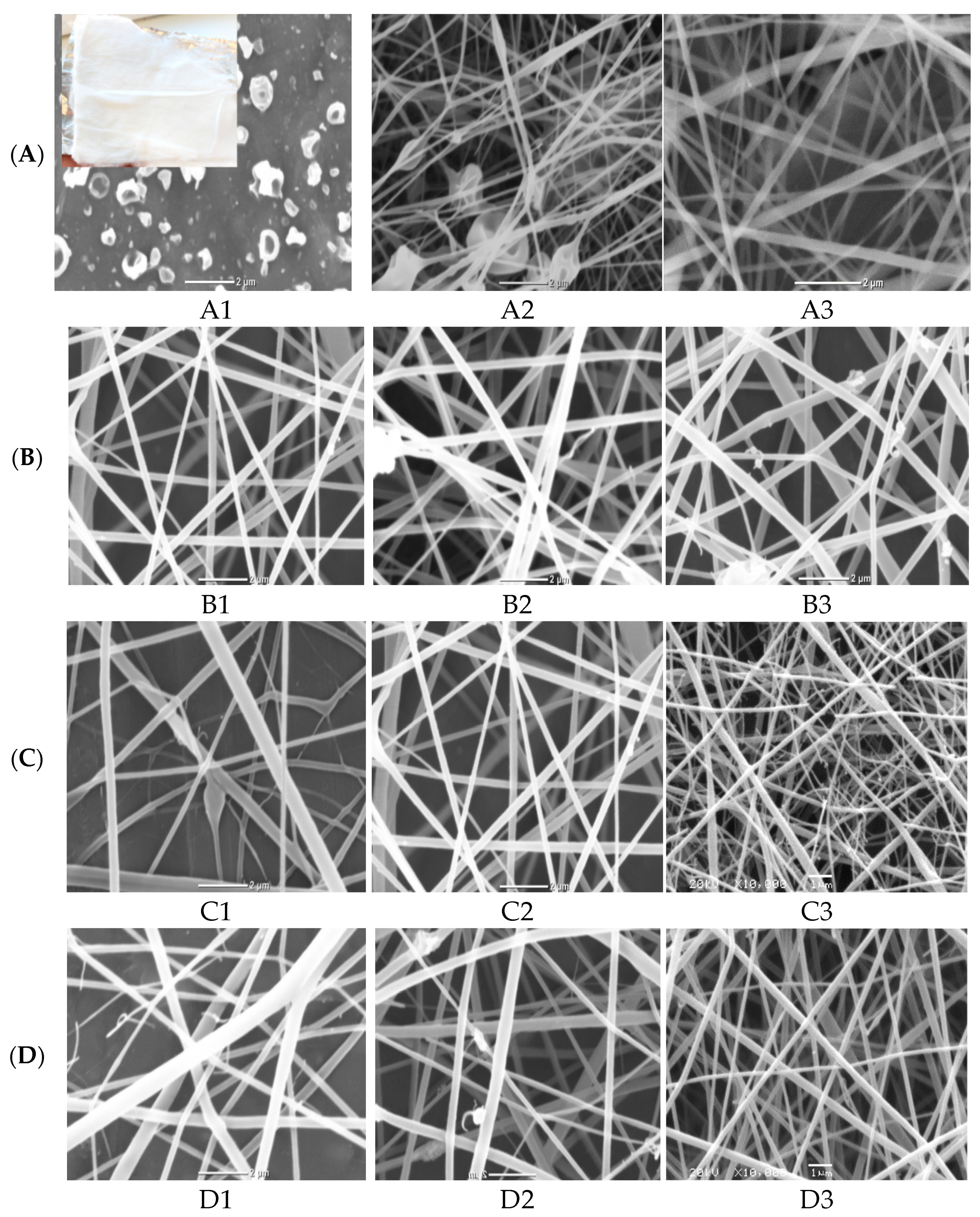

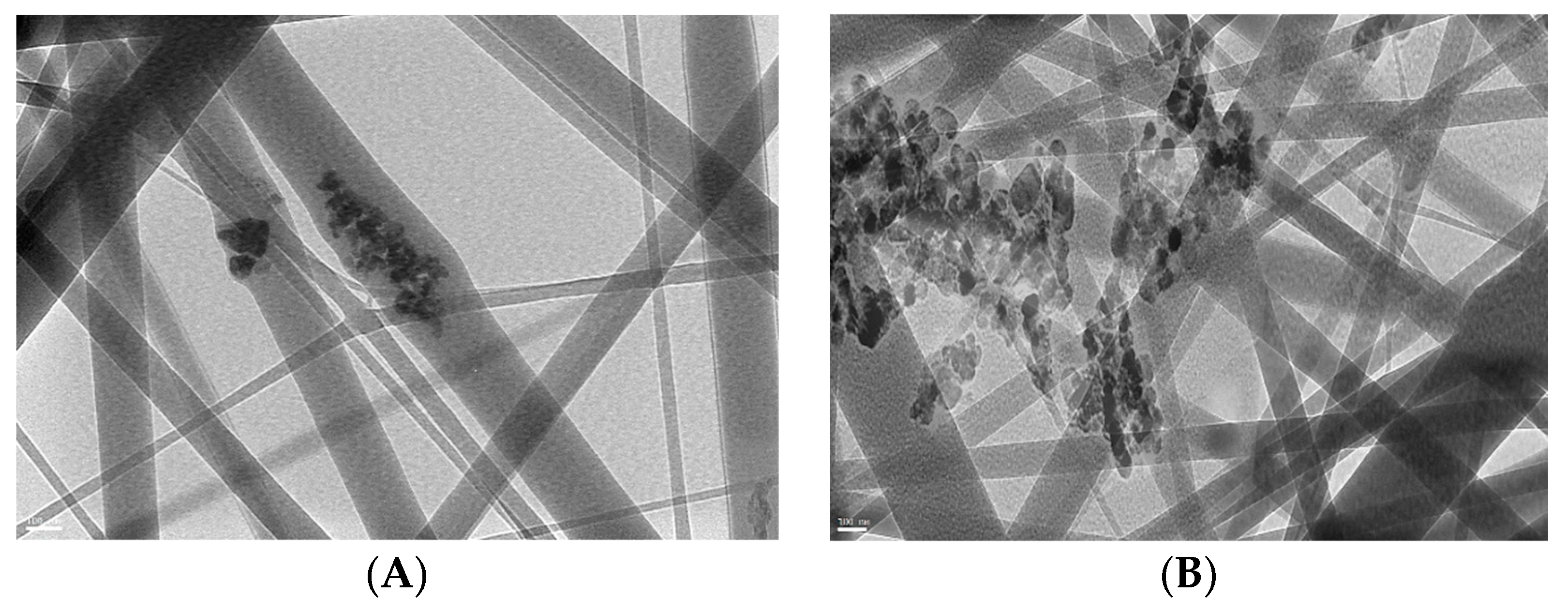

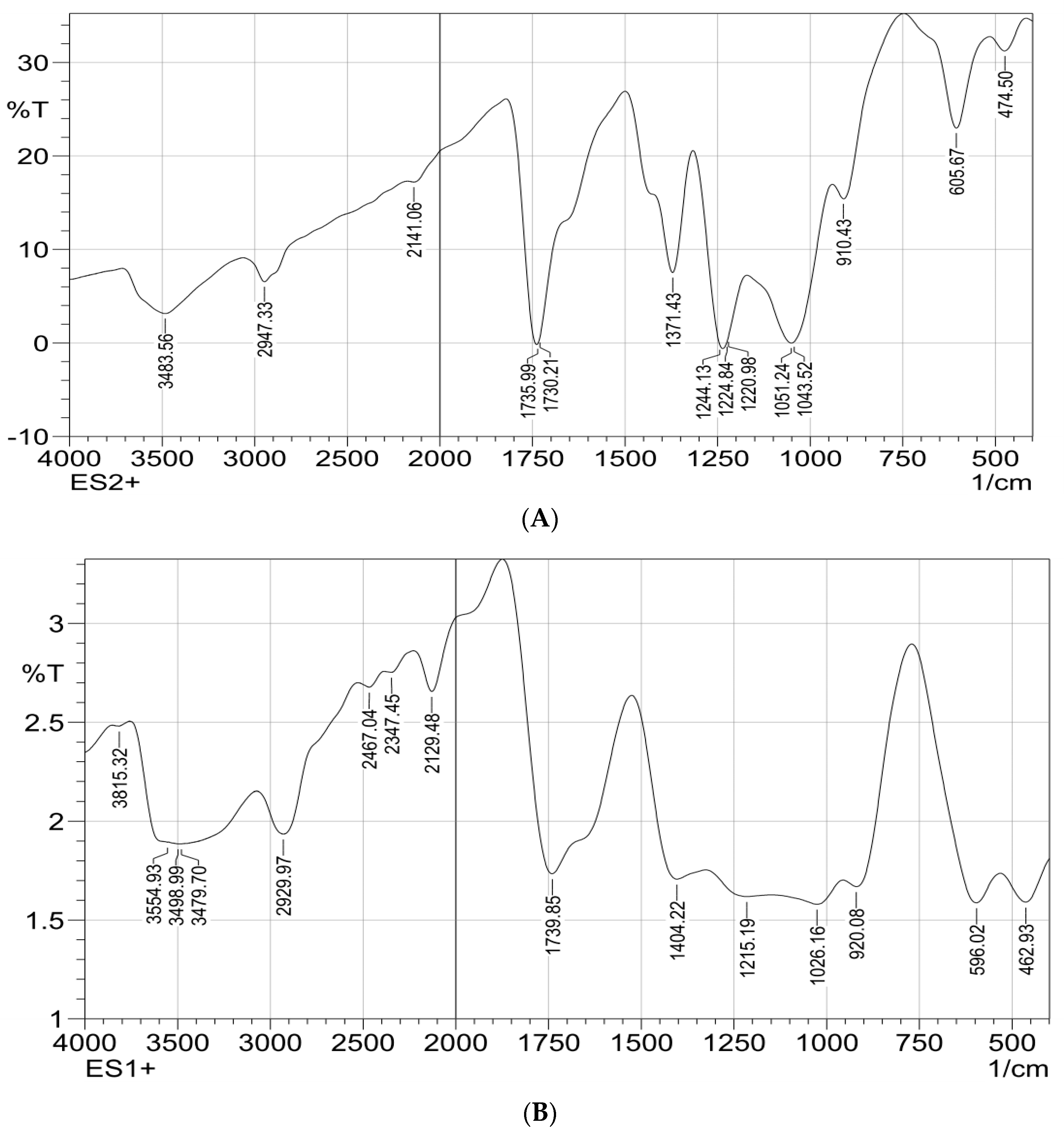
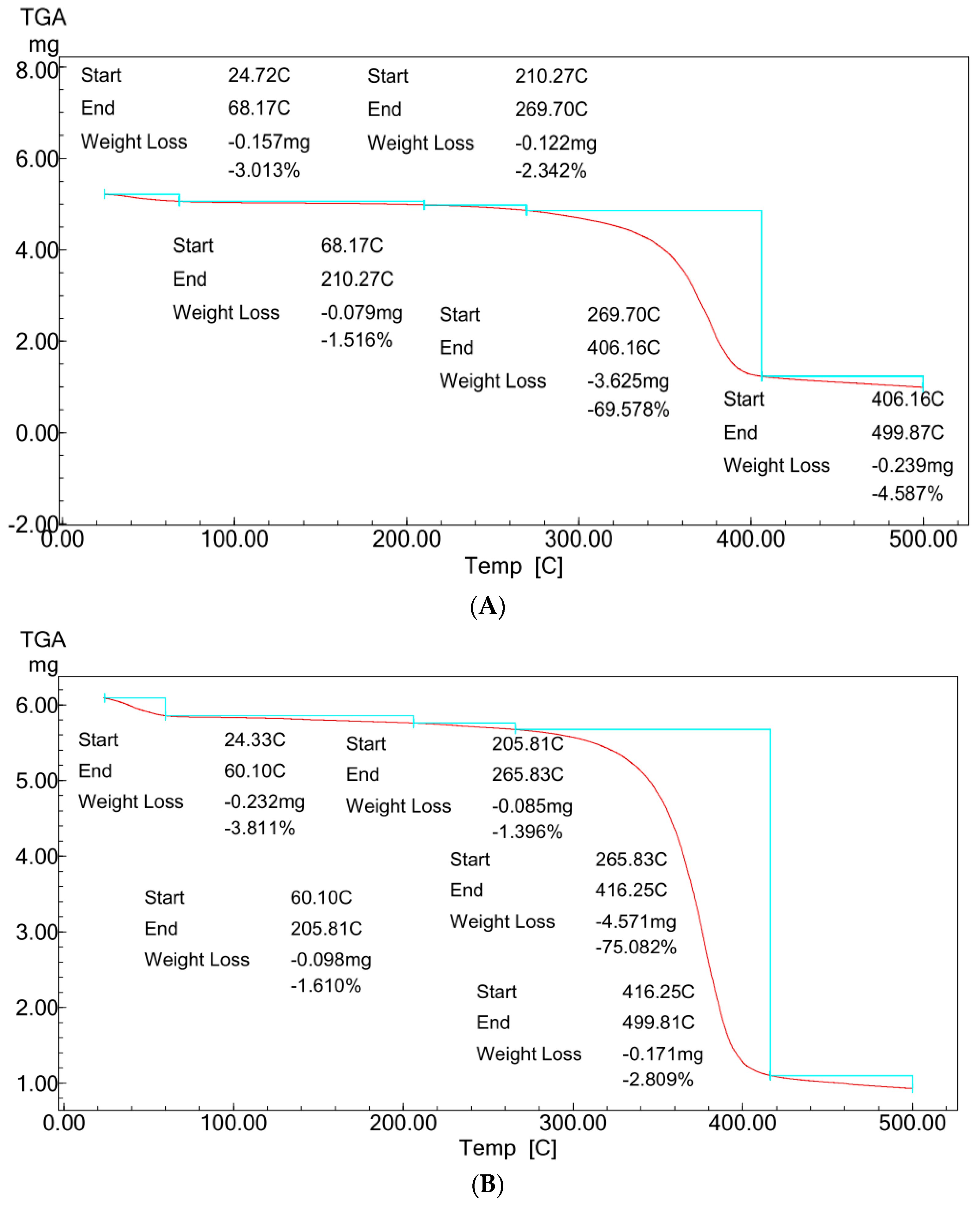


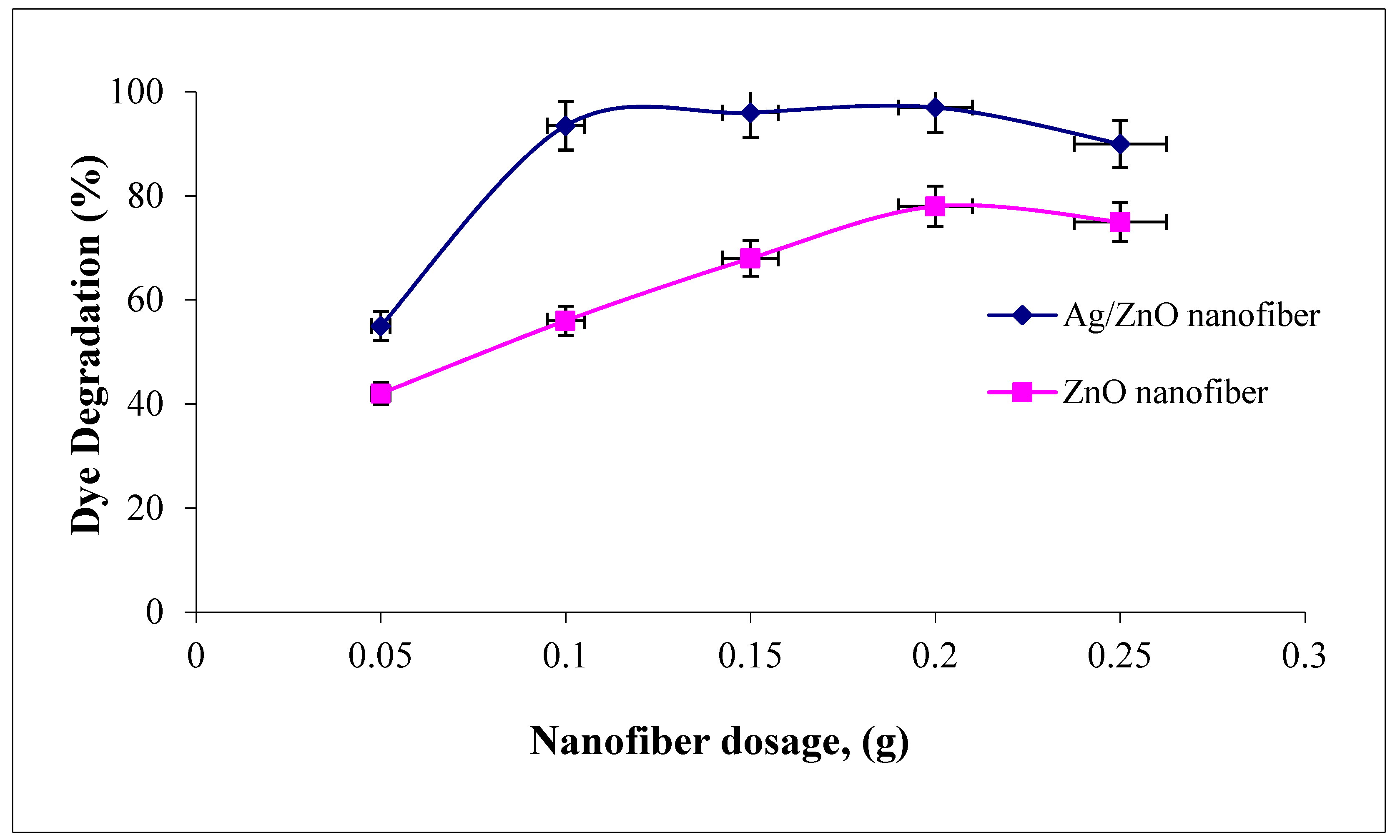


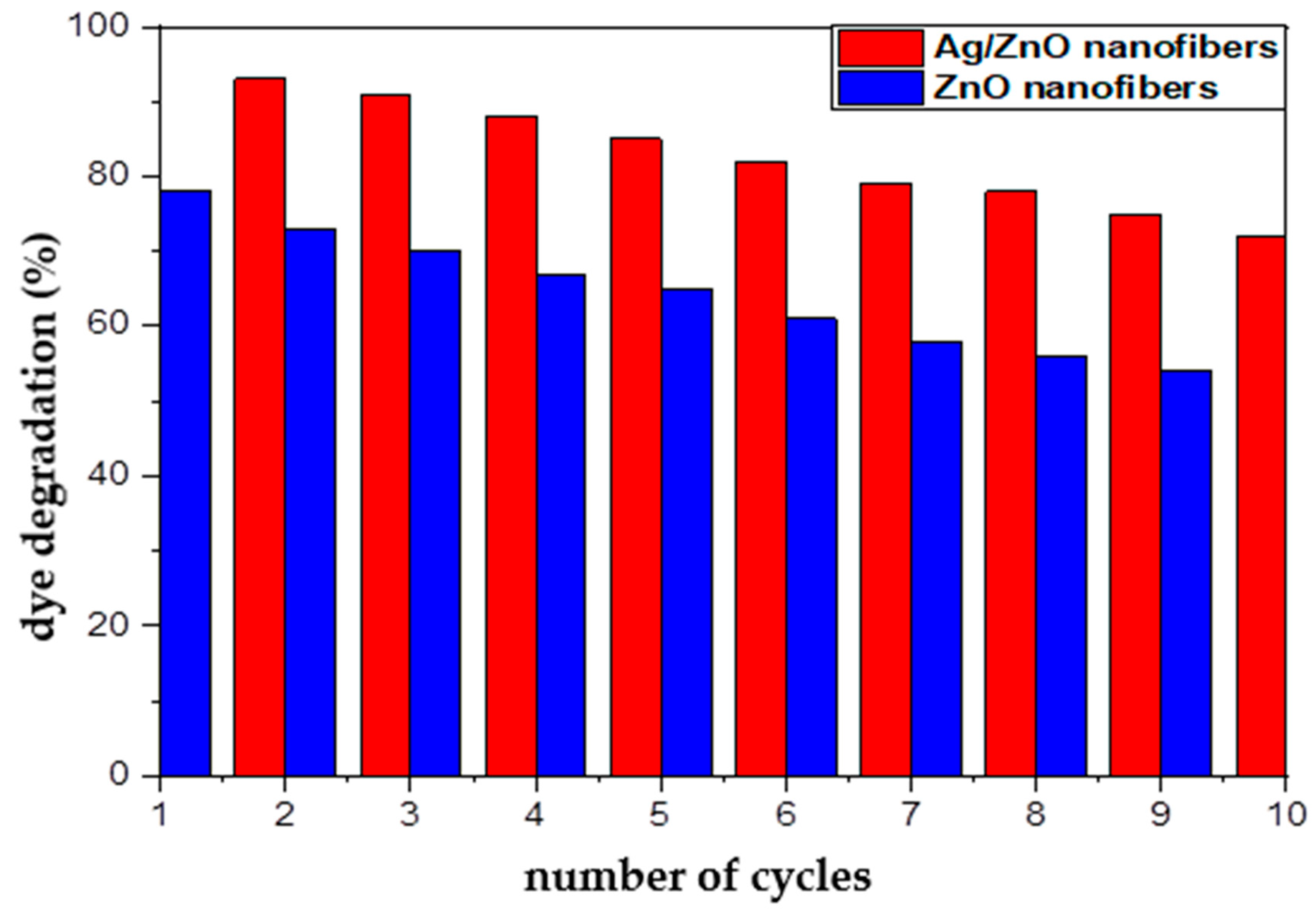

Publisher’s Note: MDPI stays neutral with regard to jurisdictional claims in published maps and institutional affiliations. |
© 2021 by the authors. Licensee MDPI, Basel, Switzerland. This article is an open access article distributed under the terms and conditions of the Creative Commons Attribution (CC BY) license (https://creativecommons.org/licenses/by/4.0/).
Share and Cite
Elkady, M.F.; Hassan, H.S. Photocatalytic Degradation of Malachite Green Dye from Aqueous Solution Using Environmentally Compatible Ag/ZnO Polymeric Nanofibers. Polymers 2021, 13, 2033. https://doi.org/10.3390/polym13132033
Elkady MF, Hassan HS. Photocatalytic Degradation of Malachite Green Dye from Aqueous Solution Using Environmentally Compatible Ag/ZnO Polymeric Nanofibers. Polymers. 2021; 13(13):2033. https://doi.org/10.3390/polym13132033
Chicago/Turabian StyleElkady, Marwa F., and Hassan Shokry Hassan. 2021. "Photocatalytic Degradation of Malachite Green Dye from Aqueous Solution Using Environmentally Compatible Ag/ZnO Polymeric Nanofibers" Polymers 13, no. 13: 2033. https://doi.org/10.3390/polym13132033




